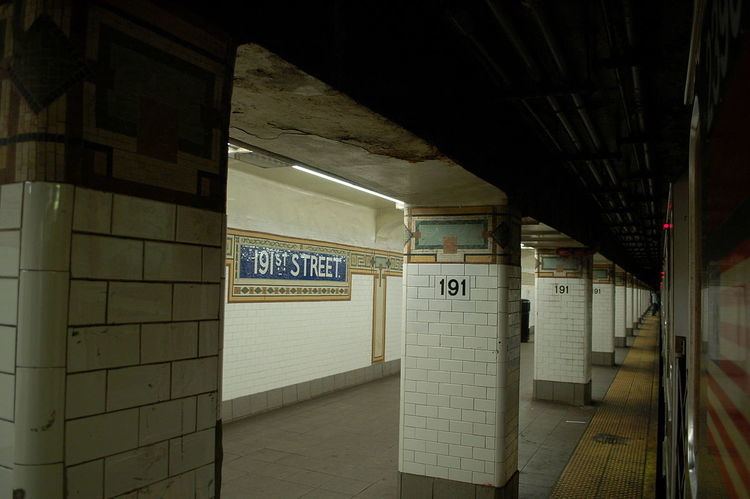Division A (IRT) Transit connections NYCT Bus: M3, M101 Depth 180 feet (55 m) Borough Manhattan Tracks 2 | Services 1 (all times) Structure Underground Opened 14 January 1911 Locale Washington Heights | |
 | ||
Line IRT Broadway–Seventh Avenue Line Address New York, NY 10040, United States Similar 181st Street, 215th Street, 207th Street, Van Cortlandt Park–242, Dyckman Street | ||
191st Street is a station on the IRT Broadway–Seventh Avenue Line of the New York City Subway. Located at the intersection of St. Nicholas Avenue and 191st Street in Manhattan, it is served by the 1 train at all times.
Contents
History
The West Side Branch of the first subway was extended northward to a temporary terminus of 221st Street and Broadway on March 12, 1906 with the station at 191st Street not yet open. The elevators and other work had not yet been completed, and 191st Street did not open to the public until January 14, 1911.
In 1948, platforms on the IRT Broadway–Seventh Avenue Line from 103rd Street to 238th Street were lengthened to 514 feet to allow full ten-car express trains to platform. Previously the stations could only platform six car local trains. The platform extensions were opened in stages. On April 6, 1948, the stations from 103rd Street to Dyckman Street had their platform extensions opened, with the exception of the 125th Street, which had its opened on June 11, 1948.
Station layout
The 191st Street station has two tracks and two side platforms. There are also covered pedestrian footbridges connecting the two platforms, so people on the footbridges cannot see the tracks and platforms (and vice versa).
At approximately 180 feet (55 m) below street level, it is the deepest station in the New York City Subway system. In 1954, Victor Hess used the station to conduct experiments on the nature of cosmic rays, the discovery of which he won the 1936 Nobel Prize in Physics for; Hess's experiments at the station involved measuring the radioactivity of the granite deposits above the station. Despite this station's depth, the next station north, Dyckman Street, is just above ground level. This is because 191st Street is at nearly the highest point on the island of Manhattan and this station is deep in the Washington Heights Mine Tunnel, while Dyckman Street runs along a deep valley almost at sea level and its station is at the tunnel portal, despite the fact that both stations are at the same elevation above sea level.
In 1981, the MTA listed the 191st Street station among the 69 most deteriorated stations in the subway system. The station was completely renovated in 2003–2004 by the New York City Transit Authority. All of the deteriorating tiles and mosaics were replaced with exact reproductions of the originals made by Serpentile, a company that does reproductions of original subway motifs. The tiles are all unglazed porcelain a half inch wide. Each of the 72 columns had to be plastered and prepared for four-sided mosaics that wrap around each one. There are 72 vertical panels, and over 3500 linear feet of mosaics. New York City Transit construction crews did all of the tile and installation work.
Exits
There are two entrances/exits from this station via the same fare control. The main entrance/exit at the southwest corner of 191st Street and St. Nicholas Avenue is at the summit of a hill and accessible only by a set of four elevators. The elevators to the platforms still utilize elevator operators, and the station is one of the only stations in the system to do so. The other entrance/exit, at 190th Street and Broadway, is at a hillside and accessed via a three-block long passageway, which passes under Wadsworth Terrace and Avenue.
The 900-foot-long (270 m) passageway between the station's Broadway entrance and the station itself is not maintained by the MTA, despite being marked as a subway entrance. It is a property of the New York City Department of Parks and Recreation and is officially called "Tunnel Street." The tunnel is also used as a connector between western and eastern Washington Heights; passengers using the other entrance, at 191st Street and St. Nicholas Avenue, need to take an elevator to access the station due to that intersection's height, and the elevators at that entrance are considered a convenient way to traverse the neighborhood without walking up a hill.
In the early 1990s, as the city's crime rates reached an all-time high, the station was considered very dangerous, with 11 crimes having taken place there in the year 1990, many of which were suspected to happen in the tunnel. The tunnel was dimly lit, covered with graffiti, and strewn with garbage at the time. In September 2014, improvements started on the tunnel, which area residents had complained about. The tunnel, which had graffiti and illegal bicycle riding, was slated to get several murals and some new LED lighting.
The passageway has been painted with murals since the late 2000s, in an effort to beautify the tunnel. In 2008, a mural was painted on the passageway leading up from Broadway to the station, as part of the Groundswell Community Mural Project. The mural was called "New York is a Rollercoaster". It was later vandalized, and in May 2015, it was painted over. Since then, the passageway's artwork has consisted of five murals. As part of a tunnel beautification program, the New York City Department of Transportation chose four artists and one team of artists, out of an applicant pool of 150. Each were chosen to paint a 200 feet (61 m) section of the tunnel. From the Broadway entrance to the station fare control, the artworks are Queen Andrea's "Prismatic Power Phrases"; Jessie Unterhalter and Katey Truhn's "Caterpillar Time Travel"; Cekis's "It's Like A Jungle/Aveces Es Como Una Jungle"; Nick Kuszy]'s "Warp Zone"; and Cope2's "Art is Life". For $15,000 each, the artists worked for over a week on their art.
